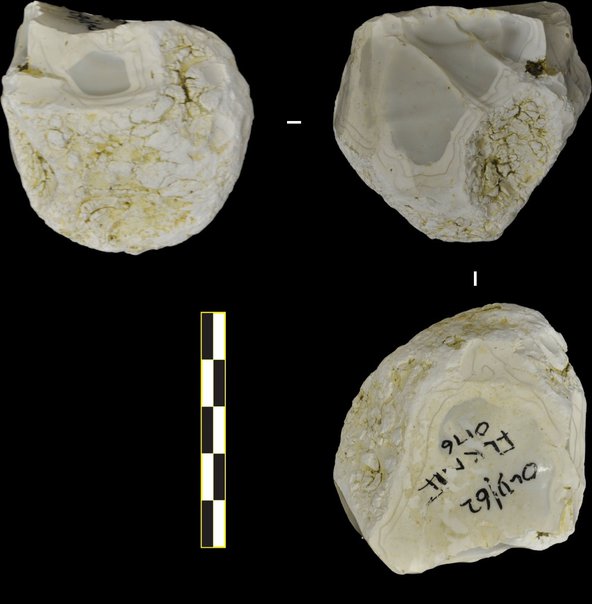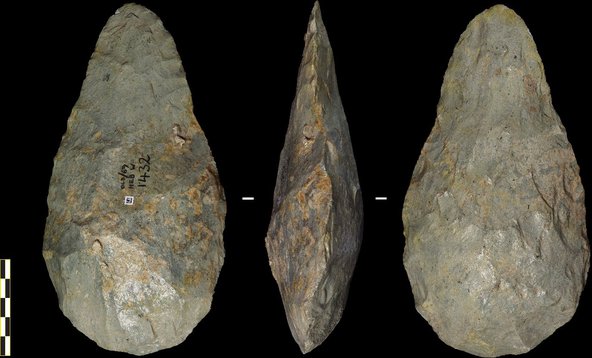How did we invent technology?
by Dr Tomos Proffitt and Dr Alastair Key
26 Apr 2019
This blog post is part of our Summer Showcase series, celebrating our free festival of ideas for curious minds.
Human beings are a technological species. We have populated every corner of our globe, landed on the moon and even sent a robot to an asteroid hurtling through space. Each one of you is reading this blog on a computer or a phone, using technology that has transformed our lives in a few short decades. As a species, we are not only entirely dependent on being able to make and use tools to survive, but we are unique in the complexity of our technologies. Scientists who are interested in human origins are faced with the fundamental questions: when and how did our species start using tools, and why did they start to become complex? As archaeologists, we address these questions by looking at the earliest evidence we have for human technology: stone tools.
Our first experiments with technology
The earliest stone tools made by humans were simple affairs. They consisted of small sharp-edged flakes purposefully and skilfully detached from larger ‘cores’ of stone, using cobbles as hammerstones. Experiments have shown that this process, known as knapping, requires control of both the hammerstone’s speed and accuracy, and the angle at which the core is held. This early technology is referred to as the Oldowan industrial complex, named after Olduvai Gorge in North Western Tanzania, where it was first identified. The Oldowan was used from around 2.6 million years ago until about 1.4 million years ago. Oldowan technology was followed by the Acheulean (named after the village of St Acheul in Northern France), a more complex and varied technology. The Acheulean is our longest-lived technology, first emerging 1.76 million years ago and in use until around 160,000 years ago. Unlike earlier Oldowan stone tool production methods, Acheulean technology included a range of large heavy-duty cutting tools called handaxes, cleavers and picks.
Together, these two stone tool-making methods represent around 95% of the time humans have been using technology. In that sense, they could already be considered the quintessential human technologies.


New discoveries of ancient tools
Recent discoveries in Kenya suggest that stone-tool use and making could be older still. In 2015, a completely different stone tool technology was discovered, at a site called Lomekwi 3 on the western shore of Lake Turkana in Kenya. Named the Lomekwian, it consists of large stone flakes detached from large cores, some of which had also been used as anvils for an as-yet unknown percussive activity. These finds were dated to 3.3 million years ago – much earlier than the previous discoveries. The large size of these artefacts already made them unique, but they are also remarkable for their method of production. Instead of being manufactured by handheld percussion, these flakes were produced by intentionally striking a large core against a stationary anvil, a technique known as passive hammer knapping. The hominin authors had a basic understanding of how to produce sharp-edged flakes.
This discovery is ground-breaking not only because it pushes back the boundaries of when our ancestors made and used stone tools, but also because it has significant implications for our understanding of which specific species of early human or hominin, made the earliest stone technologies. It has been generally understood that the development of stone tool technology was closely associated with the emergence of our own genus, Homo, but the discovery of the artefacts from Lomekwi has challenged this assumption. The Lomekwian stone tools were found close to where fossil remains of a different genus, the hominin Kenyanthropus platyops, were found. This hominin occupied the Turkana basin at roughly the same time, around 3.5 million years ago. Other early human species that belong to the genus Australopithecus are also found in East and Southern Africa at the same time. Before the discovery at Lomakwi, these small-brained human ancestors were once considered to have too small a brain size to undertake such technological feats.
Studying other primates
In trying to understand how humans first came to use stone tools, archaeologists have recently started to look at non-human primates that also use stone tools. These include chimpanzees from West Africa, long-tailed macaques from southern Thailand, and capuchin monkeys from north eastern Brazil. All these groups of primates frequently use stone tools to break open different foods. Each species uses tools in a fundamentally similar way, but with some crucial differences.

All use a stone hammer to crack open a nut, fruit, seed or shell, which is placed on either a stone or wooden anvil. Perhaps surprisingly, macaques and capuchins use stone tools in a wider variety of ways than chimpanzees. Macaques also use them to prise oysters away from shoreline boulders, while capuchin monkeys use stones in the widest variety of behaviours, including nut and seed cracking, fruit processing, digging for roots and spiders, pulverising quartz dust, and sexual displays.
Primatologists and archaeologists have noticed that during capuchin percussive behaviours, occasionally the hammerstone will accidentally miss the intended target nut and instead impact the stone anvil. Occasionally, these mis-hits result in a fracture, accidentally detaching sharp-edged flake. In no cases have these primates ever been observed to re-use these flakes as cutting tools. However, the accidental nature of their production has led some to suggest that early human stone tool technology, such as the Lomekwian, may have had similar percussive beginnings. As such, these primate percussive behaviours may be good models for understanding the development of our tool use.
Some have also suggested that instead of hammer and anvil use to crack open nuts being a precursor to stone tool production, that hammerstones were used to break open bones to get access to bone marrow, a good source of fats and proteins. In this way, heavy-duty percussive activities may represent the earliest hominin stone tool use.
Our research deals with not only how primates use stone tools, and how these behaviours and artefacts help us search for similar early human tools, but also how and why humans developed more complex technologies, from the Lomekwian through to the Acheulean. By understanding how and why primates currently use stone tools and by undertaking experiments looking at how modern humans use stone tools we hope to develop a greater understanding of how our earliest ancestors developed and used the first technology.
Dr Alastair Key was awarded a Postdoctoral Fellowship from the British Academy in 2016 and is completing his research at the University of Kent. Dr Tomos Proffitt was awarded a British Academy Postdoctoral Fellowship in 2017 and is completing his research at University College London.


